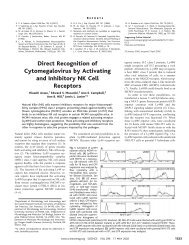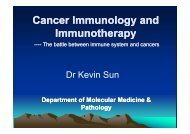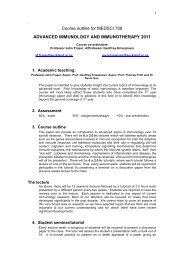Topic 2 lecture note..
Topic 2 lecture note..
Topic 2 lecture note..
You also want an ePaper? Increase the reach of your titles
YUMPU automatically turns print PDFs into web optimized ePapers that Google loves.
neutrophil transmigration through cytokine activated endothelium by 70-90%. Binding of<br />
leukocytes to endothelium is not affected. Although V3 integrin can be a ligand for<br />
PECAM-1, and monocytes lacking 3-integrin transmigrate poorly, this appears to be<br />
due to modulation of CD11a/CD18 rather than by an interaction with PECAM-1. In<br />
contrast to cytokine-activated transmigration, PECAM-1 seems to have little role in<br />
chemotactic transmigration. PECAM-1 antibodies do not decrease chemotactic<br />
transmigration in vivo, nor do they decrease transmigration triggered by thrombin. In<br />
addition, there is often a significant residual transmigration (~10-30%) after PECAM-1<br />
inhibition which suggests that other mechanisms may operate in passage through the<br />
junction in cytokine-activated transmigration. These observations suggest that the<br />
mechanisms operating in cytokine-activated and chemotactic transmigration overlap to<br />
only a small degree. Neutrophils and monocytes from CD11a knock out mice do not<br />
require PECAM-1 for transmigration, suggesting that CD11a and PECAM-1 somehow<br />
operate in a similar pathway of migration. However, PECAM-1 knockout mice show no<br />
clear evidence of a transmigration defect.<br />
The involvement of VLA-4 in transmigration in vitro is variable. It is likely this reflects<br />
redundancy with 2-integrins, as well as the degree of VCAM-1 expression on<br />
endothelium, which in turn reflects the state of endothelial activation. It appears<br />
unimportant in neutrophil transmigration in vitro, and in transmigration of activated T-<br />
cells. Resting T-cell and NK cell cytokine-activated transmigration are reduced by 40%<br />
and 30% respectively (Oppenheimer Marks et al 1991; Bianchi et al 1993). As firm<br />
adhesion is reduced to a similar extent it is unclear whether this is a specific effect on<br />
passage across the endothelium.<br />
**************************************************************************************<br />
Ectoenzymes in the control of leukocyte traffic<br />
Ectoenzymes are membrane proteins that have their active site outside the cell. They<br />
include proteases, nucleotidases, and oxidases, which can regulate leukocyte<br />
transmigration.<br />
Nucleotidases:<br />
ATP is proinfammatory: ATP binds purinergic receptors of the P2X and P2Y<br />
families, and induces proliferation by inducing cytokine expression, and activating<br />
dendritic cells.<br />
Adenosine is anti-infammatory: Adenosine inhibits neutrophil adhesion to the<br />
microvascular endothelium by activating the adenosine receptors A 2A R abd A 2B R on<br />
neutrophils. Adenosine prevents leukocyte activation- it inhibits L-selectin shedding and<br />
expression of CD18 integrins by leukocytes, and down-regulates VCAM-1 and cytokine<br />
expression by endothelial cells.<br />
CD73





